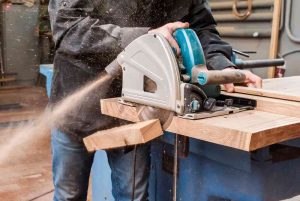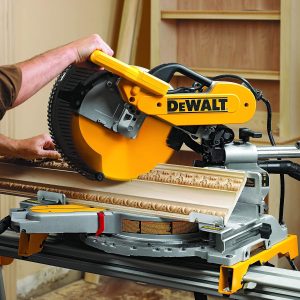Precision is paramount in woodworking and construction, and nowhere is this more critical than when making accurate angle cuts with a miter saw. Whether you’re a professional carpenter, a dedicated DIY enthusiast, or an occasional weekend warrior, having a reliable angle finder can make the difference between a perfect fit and frustrating gaps.
While premium angle searcher offer exceptional accuracy and features, their high price point has led many to explore quality alternatives that provide excellent value without compromising on performance.
This comprehensive guide will explore the best angle finders for miter saws available now, helping you make an informed decision that balances your budget with your precision requirements.
Best Angle Finders for Miter Saw
Understanding Angle Finder Types
Before diving into specific products, it’s essential to understand the different types of angle finders available on the market:
Digital Angle Finders
Digital angle finders use electronic sensors to measure angles with high precision, typically displaying readings on an LCD screen. These devices offer accuracy to within 0.1 or 0.2 degrees and often include additional features like hold functions, zero calibration, and conversion between different angle measurement units.
Analog/Manual Angle Finders
Traditional analog angle finders use mechanical components and a graduated scale to determine angles. While they may lack the precision of digital models, they’re often more durable, don’t require batteries, and can be easier to read in bright sunlight.
Smartphone Angle Finder Apps
Modern smartphones come equipped with accelerometers and gyroscopes that can be used to measure angles through specialized apps. While convenient and cost-effective, these may lack the precision and durability of dedicated tools.
Integrated Miter Saw Angle Systems
Many high-end miter saws now come with built-in digital angle displays and laser guides. These integrated systems offer convenience but are limited to use with that specific tool.
Key Factors to Consider When Choosing an Angle Finder
Accuracy and Precision
The primary purpose of an angle finder is to provide accurate measurements. Look for devices with accuracy of at least ±0.3 degrees for general woodworking, and ±0.1 degrees for fine woodworking or professional applications where precision is critical.
Ease of Use
Consider how intuitive the device is to operate. Features like automatic shut-off, simple calibration processes, and clear displays contribute to a user-friendly experience. For professionals working on job sites, ease of use can significantly impact productivity.
Durability and Build Quality
Angle finders used in workshop or job site environments need to withstand occasional drops, dust, and moisture. Look for robust construction, quality materials, and appropriate IP (Ingress Protection) ratings if you’ll be working in harsh conditions.
Display Type and Readability
A clear, easy-to-read display is essential, especially in varying light conditions. Backlit displays are valuable for working in dimly lit spaces, while high-contrast screens perform better in bright sunlight.
Battery Life (for Digital Models)
For digital angle finders, battery life is a crucial consideration. Look for devices that offer extended battery life (100+ hours of continuous use) and feature auto-shutoff to preserve power. Models that use common battery types (like AA or AAA) are more convenient than those requiring specialty batteries.
Size and Portability
Consider the size and weight of the angle finder, especially if you’ll be carrying it between job sites. Compact models are easier to transport but may sacrifice some features or screen size.
Additional Features
Extra features can enhance functionality and value:
- Hold function to freeze measurements.
- Zero calibration at any position.
- Conversion between degrees, radians, and other units.
- Magnetic base for hands-free use.
- Bubble vials for level verification.
- Data storage or Bluetooth connectivity for recording measurements.
Price Point
Angle finders range from budget-friendly options under $20 to professional-grade models costing $200 or more. Determine your budget based on how frequently you’ll use the tool and the level of precision required for your projects.
ProAngle Digital Protractor

ProAngle’s Digital Protractor offers professional-grade accuracy in a user-friendly package. Engineered for precision woodworking and construction, this device delivers reliable measurements with intuitive operation and robust construction suitable for job site conditions.
ProAngle Digital Protractor Specifications:
- Accuracy: ±0.1 degrees.
- Range: 0-360 degrees.
- Display: Backlit LCD.
- Battery: CR2032 (300+ hours).
- Dimensions: 7.5″ x 2.5″ x 0.6″.
- Warranty: 2 years.
Pros
- Exceptional accuracy suitable for fine woodworking.
- Durable aluminum construction with IP54 protection.
- Long battery life with automatic shut-off.
- Magnetic base for hands-free operation.
- Simple calibration process.
- Hold function to freeze measurements.
Cons
- Premium price point.
- Smaller display than some competitors.
- Limited availability in some regions.
Best For: Professional carpenters, cabinet makers, and serious woodworkers who demand the highest level of precision for their projects.
AccuMark Analog Angle Finder

AccuMark’s Analog Angle Finder combines traditional reliability with modern design elements. This mechanical angle finder requires no batteries and provides clear, immediate readings in any lighting condition, making it a dependable choice for both workshop and job site use.
AccuMark Analog Angle Finder Specifications:
- Accuracy: ±0.5 degrees.
- Range: 0-180 degrees.
- Display: Mechanical scale with magnifier.
- Construction: Stainless steel with brass components.
- Dimensions: 8″ x 2″ x 0.25″.
- Warranty: Lifetime.
Pros
- No batteries required.
- Excellent durability with all-metal construction.
- Easy to read in bright sunlight.
- Simple operation with no learning curve.
- Lifetime warranty.
- Lightweight and portable.
Cons
- Lower precision than digital models.
- No additional features like a hold function.
- It can be affected by parallax error if not viewed straight on.
- Limited to a 180-degree range.
Best For: Traditional woodworkers, DIY enthusiasts, and professionals who prefer simple, reliable tools without electronic components.
SmartMeasure Pro Digital Angle Finder

SmartMeasure Pro brings innovation to angle measurement with its advanced digital angle finder featuring Bluetooth connectivity and smartphone integration. This device combines high precision with smart features that streamline workflow and improve record-keeping.
SmartMeasure Pro Digital Angle Finder Specifications:
- Accuracy: ±0.2 degrees.
- Range: 0-360 degrees.
- Display: Color LCD with multiple viewing modes.
- Battery: Rechargeable lithium-ion (40+ hours per charge).
- Connectivity: Bluetooth 5.0.
- Dimensions: 9″ x 2.8″ x 0.8″.
- Warranty: 3 years.
Pros:
- Advanced features, including measurement storage and recall.
- Smartphone app for project documentation.
- Rechargeable battery with USB-C charging.
- High-contrast display with adjustable brightness.
- Multiple measurement modes (absolute, relative).
- Excellent build quality with a rubberized grip.
Cons:
- Higher price point.
- Learning curve for advanced features.
- Requires regular charging.
- Smartphone app requires a subscription for full features.
Best For: Tech-savvy professionals, contractors who need to document measurements, and woodworkers who appreciate digital integration in their workflow.
Craftsman Companion Digital Angle Finder

Craftsman Companion offers an excellent balance of performance and value in its Digital Angle Finder. Designed for both DIY enthusiasts and professionals, this device provides reliable accuracy and essential features without the premium price tag of high-end models.
Craftsman Companion Digital Angle Finder Specifications
- Accuracy: ±0.3 degrees.
- Range: 0-360 degrees.
- Display: Large backlit LCD.
- Battery: AAA batteries (200+ hours).
- Dimensions: 8″ x 2.5″ x 0.7″.
- Warranty: 1 year.
Pros:
- Excellent value for money.
- Large, easy-to-read display.
- Simple operation with intuitive controls.
- Durable construction suitable for job site use.
- Locking screw to maintain measurements.
- Auto-shutoff preserves battery life.
Cons:
- Lower accuracy than professional models.
- Basic feature set without advanced functions.
- Shorter warranty period than premium options.
- Plastic construction is less durable than metal alternatives.
Best For: DIY enthusiasts, homeowners, and professionals looking for a reliable, budget-friendly angle finder for occasional to regular use.
PrecisionPro Miter Saw Digital Gauge

PrecisionPro’s Miter Saw Digital Gauge is specifically designed for use with miter saws, featuring a unique mounting system that attaches directly to most miter saw fences. This specialized design provides unparalleled convenience for setting precise miter and bevel angles.
PrecisionPro Miter Saw Digital Gauge Specifications:
- Accuracy: ±0.1 degrees.
- Range: 0-360 degrees.
- Display: Articulating LCD.
- Battery: CR2032 (250+ hours).
- Mounting: Universal miter saw fence mount.
- Dimensions: 6″ x 2″ x 1″ (gauge only).
- Warranty: 2 years.
Pros:
- Designed specifically for miter saw applications.
- Hands-free operation when mounted.
- Articulating display for optimal viewing angle.
- High precision suitable for fine woodworking.
- Mounting system compatible with most miter saws.
- Compact design doesn’t interfere with operation.
Cons:
- Specialized design limits versatility for other applications.
- Higher price than general-purpose angle finders.
- The mounting system may not fit all miter saw models.
- More complex setup than standalone angle finders.
Best For: Woodworkers who primarily need angle measurement for miter saw operations and want the convenience of a dedicated, mounted solution.
Premium vs. Budget Angle Finders: A Detailed Comparison
Performance
Premium Angle Finders: High-end models like the ProAngle Digital Protractor and SmartMeasure Pro deliver exceptional accuracy (±0.1 to ±0.2 degrees) and maintain precision even after extended use. Their advanced sensors and quality components ensure consistent performance across various conditions.
Budget Angle Finders: More affordable options like the Craftsman Companion offer respectable accuracy (±0.3 degrees), suitable for most DIY projects, but may show slight variations under heavy use or extreme temperatures. They lack the advanced calibration features found in premium models.
Durability and Lifespan
Premium Angle Finders: Constructed with high-quality materials like aluminum, stainless steel, and impact-resistant polymers, premium angle finders typically last 5+ years with proper care. They often feature better protection against dust and moisture, making them suitable for job site conditions.
Budget Angle Finders: While functional, budget models generally use more plastic components and may show signs of wear after 2-3 years of regular use. They’re better suited to workshop environments than harsh job site conditions.
Price Comparison
Premium Angle Finders: High-end digital angle finders typically range from $150 to $250, representing a significant investment for occasional users but justifiable for professionals who rely on precision daily.
Budget Angle Finders: Quality budget options range from $30 to $80, offering excellent value for DIY enthusiasts and occasional users who don’t require professional-grade precision.
Feature Comparison
Premium Angle Finders: Premium models include advanced features like Bluetooth connectivity, measurement storage, multiple display modes, and superior build quality. These features enhance productivity and provide greater versatility for various applications.
Budget Angle Finders: Budget models focus on core functionality with basic features like hold functions and simple calibration. They lack the advanced capabilities of premium options but provide all the essential functions for most angle measurement tasks.
Warranty and Customer Support
Premium Angle Finders: Premium brands typically offer 2-3 year warranties with responsive customer service and straightforward replacement processes. Some, like the AccuMark Analog, even offer lifetime warranties.
Budget Angle Finders: Budget options usually come with 1-year warranties, and the claims process may be less straightforward. Customer support quality varies significantly by brand.
Tips for Maximizing the Life and Accuracy of Your Angle Finder
Proper Storage
Store your angle finder in a protective case when not in use to prevent damage. Keep it in a dry, temperature-controlled environment away from direct sunlight. For digital models, remove batteries during extended storage periods to prevent corrosion.
Calibration Techniques
Regular calibration ensures ongoing accuracy:
- Zero-calibrate your digital angle finder before each use or when changing reference surfaces
- For analog models, periodically check against known angles (like a 90-degree square)
- Follow the manufacturer’s calibration instructions precisely
- Keep calibration tools clean and in good condition
Cleaning and Maintenance
- Clean the angle finder after each use, especially in dusty environments
- Use a soft, dry cloth to wipe down the body and display
- For stubborn dirt, slightly dampen the cloth with water or a mild cleaning solution
- Never submerge digital angle finders in liquid
- Lubricate moving parts on analog models according to manufacturer guidelines.
- Check and tighten screws periodically to maintain accuracy
Battery Care for Digital Models
- Use high-quality batteries from reputable brands
- Remove batteries if the device won’t be used for extended periods
- Store spare batteries in a cool, dry place
- Recharge rechargeable models before they’re completely depleted
- Replace batteries when low battery warnings appear to maintain accuracy
Safety Considerations
Proper Usage Techniques
- Always follow the manufacturer’s instructions for operation.
- Keep fingers away from moving parts on analog models.
- Don’t force the angle finder beyond its specified range.
- Use appropriate personal protective equipment when working with power tools.
- Ensure the angle finder is properly positioned before taking measurements.
Maintenance Safety
- Disconnect or remove batteries before cleaning or maintenance.
- Use only recommended cleaning solutions and materials.
- Avoid disassembling digital angle finders, as this may void warranties and damage internal components.
- Replace damaged or worn parts immediately to maintain accuracy and safety.
Battery Safety for Digital Models
- Use only the battery type specified by the manufacturer.
- Don’t mix old and new batteries or different battery types.
- Remove batteries if the device is damaged or not functioning properly.
- Dispose of batteries according to local regulations.
- Keep batteries away from extreme heat and fire.
Conclusion
When selecting the best angle finders for miter saw, prioritize accuracy for your specific applications, consider the environments where you’ll be working, and balance upfront cost against expected lifespan and features. With proper care and maintenance, a quality angle finder will provide years of reliable service and help you achieve perfectly angled cuts every time.
Remember that while an angle finder is a valuable tool, it’s only as accurate as your technique. Take the time to learn proper measurement methods, maintain your tool regularly, and always verify critical measurements before making cuts. By making an informed decision based on your specific needs, you can enhance the precision of your work and achieve professional results regardless of your budget.





